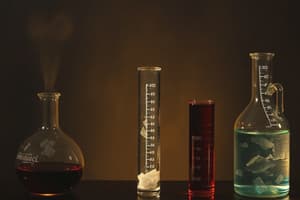Podcast
Questions and Answers
What is the coordination number of the metal-ion M in Curve A?
What is the coordination number of the metal-ion M in Curve A?
- Five
- Six
- Four (correct)
- Three
What is the type of ligand that forms a complex with metal-ion M in Curve C?
What is the type of ligand that forms a complex with metal-ion M in Curve C?
- Bidentate
- Tetradentate
- Hexadentate
- Unidentate (correct)
What is the number of potential sites for bonding a metal ion in EDTA?
What is the number of potential sites for bonding a metal ion in EDTA?
- Four
- Five
- Six (correct)
- Eight
What is the ratio of EDTA to metal ions in a reaction?
What is the ratio of EDTA to metal ions in a reaction?
Why is an auxiliary complexing agent needed in some EDTA titrations?
Why is an auxiliary complexing agent needed in some EDTA titrations?
What is another use of EDTA besides being a titrant?
What is another use of EDTA besides being a titrant?
What type of reagents are used in Complex-Formation Titrations?
What type of reagents are used in Complex-Formation Titrations?
What is the typical coordination number for most metal ions?
What is the typical coordination number for most metal ions?
What is the term for the species formed as a result of coordination?
What is the term for the species formed as a result of coordination?
What is the advantage of using multidentate ligands over unidentate ligands?
What is the advantage of using multidentate ligands over unidentate ligands?
What is the term for a ligand with two donor groups?
What is the term for a ligand with two donor groups?
What is the term for a process where a metal ion coordinates with two or more donor groups of a single ligand to form a five- or six-membered heterocyclic ring?
What is the term for a process where a metal ion coordinates with two or more donor groups of a single ligand to form a five- or six-membered heterocyclic ring?
What is the primary purpose of using a medium with high concentrations of ammonia and ammonium chloride in zinc(II) titration?
What is the primary purpose of using a medium with high concentrations of ammonia and ammonium chloride in zinc(II) titration?
What is the characteristic of Eriochrome Black T that makes it useful as an indicator in EDTA titrations?
What is the characteristic of Eriochrome Black T that makes it useful as an indicator in EDTA titrations?
What is the definition of water hardness in terms of the concentration of calcium and magnesium ions?
What is the definition of water hardness in terms of the concentration of calcium and magnesium ions?
What type of reaction is the basis of precipitation titrations?
What type of reaction is the basis of precipitation titrations?
What is the primary use of silver nitrate in titrations?
What is the primary use of silver nitrate in titrations?
What is the characteristic of indicators used in argentometric titrations?
What is the characteristic of indicators used in argentometric titrations?
What is the typical plot of a titration curve for precipitation reactions?
What is the typical plot of a titration curve for precipitation reactions?
What is the effect of increasing the solubility product on the sharpness of the end point?
What is the effect of increasing the solubility product on the sharpness of the end point?
What is the role of iron(III) in the Volhard method?
What is the role of iron(III) in the Volhard method?
What is the result of adding a slight excess of thiocyanate ion to the solution in the Volhard method?
What is the result of adding a slight excess of thiocyanate ion to the solution in the Volhard method?
What is the most important application of the Volhard method?
What is the most important application of the Volhard method?
What is the reason why silver chloride is not used in the Volhard method?
What is the reason why silver chloride is not used in the Volhard method?
Flashcards
Coordination Number
Coordination Number
The number of donor atoms directly attached to a central metal atom.
Ligand
Ligand
A molecule or ion that can donate a pair of electrons to form a coordinate covalent bond with a metal ion.
Coordination Compound
Coordination Compound
A complex compound containing a metal ion surrounded by a specific number of ligands.
Unidentate Ligand
Unidentate Ligand
Signup and view all the flashcards
Bidentate Ligand
Bidentate Ligand
Signup and view all the flashcards
Chelation
Chelation
Signup and view all the flashcards
Complexometric Titration
Complexometric Titration
Signup and view all the flashcards
Precipitation Titration
Precipitation Titration
Signup and view all the flashcards
Precipitation Reaction
Precipitation Reaction
Signup and view all the flashcards
Silver Nitrate
Silver Nitrate
Signup and view all the flashcards
Argentometric Titration
Argentometric Titration
Signup and view all the flashcards
EDTA (Ethylenediaminetetraacetic Acid)
EDTA (Ethylenediaminetetraacetic Acid)
Signup and view all the flashcards
Auxiliary Complexing Agent
Auxiliary Complexing Agent
Signup and view all the flashcards
Multidentate Ligands
Multidentate Ligands
Signup and view all the flashcards
Water Hardness
Water Hardness
Signup and view all the flashcards
End Point
End Point
Signup and view all the flashcards
Reaction Completion
Reaction Completion
Signup and view all the flashcards
Volhard Method
Volhard Method
Signup and view all the flashcards
Iron(III) Thiocyanate Reaction
Iron(III) Thiocyanate Reaction
Signup and view all the flashcards
Equivalence Point Concentration
Equivalence Point Concentration
Signup and view all the flashcards
Equilibrium
Equilibrium
Signup and view all the flashcards
Chelate Complex
Chelate Complex
Signup and view all the flashcards
Indicator
Indicator
Signup and view all the flashcards




